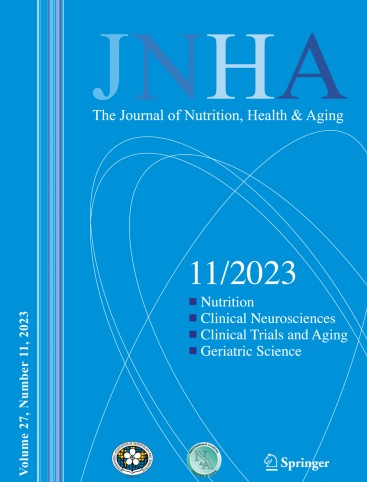Transition to retirement impact on food consumption frequency: results from a longitudinal analysis within the Survey of Health, Ageing and Retirement in Europe (SHARE)
IF 4.3
3区 医学
Q1 GERIATRICS & GERONTOLOGY
引用次数: 0
Abstract
Objectives
It has been suggested that major life course transitions, such as retirement, can greatly impact lifestyles. However, the evidence is scant and inconclusive, especially with reference to the effects on dietary habits. We investigated the long-term effects of retirement on the frequency of food consumption using data from the Survey of Health, Ageing, and Retirement in Europe (SHARE).
Design and participants
We used data from a SHARE-based cohort, including European individuals from 28 countries aged 50 and older who were employed at baseline and retired during follow-up time (2004–2020).
Measurements
Dietary habits were assessed through self-reported frequencies of consumption for fruit and vegetables, dairy products, meat and fish, legumes and eggs. A dietary score (dichotomised as ≥5 or <5) was also estimated. Generalised estimating equation models calculated relative risks (RR) of daily (for fruit, vegetables and dairy products) and 3−6 times per week (for meat, fish, legumes and eggs) consumptions before and after retirement, adjusting for selected variables.
Results
The cohort included 8,998 individuals with a mean follow-up time of 9 years. Baseline daily consumption frequencies were 73.7% for fruit and vegetables and 65.9% for dairy products, while 3−6 times per week frequencies were 39.8% for meat and fish and 26.1% for legumes and eggs. An increase in 3−6 times a week consumption of meat and fish (RR 1.07, 95% CI 1.01–1.13) and legumes and eggs (RR 1.09, 95% CI 1.01–1.17) was observed 10 or more years post-retirement. Daily consumption of fruit and vegetables, and dairy products remained stable. The RR of a dietary score ≥5 post-retirement was 1.11 (95% CI 1.06–1.16, 10 or more years after).
Conclusions
Retirement positively appears to influence overall dietary habits, particularly by improving the consumption frequency of protein-rich foods, while the stability in fruit, vegetables, and dairy consumption suggests that well-established habits persist despite life transitions.
向退休过渡对食品消费频率的影响:来自欧洲健康、老龄化和退休调查(SHARE)的纵向分析结果
有人认为,人生的重大转变,如退休,会极大地影响生活方式。然而,证据不足且不确定,特别是关于饮食习惯的影响。我们利用欧洲健康、老龄化和退休调查(SHARE)的数据调查了退休对食物消费频率的长期影响。设计和参与者我们使用了基于share的队列数据,包括来自28个国家的50岁及以上的欧洲人,他们在基线时工作,在随访期间退休(2004-2020年)。饮食习惯通过自我报告的水果和蔬菜、乳制品、肉类和鱼类、豆类和鸡蛋的消费频率来评估。饮食评分(分为≥5或<;5)也被估计。广义估计方程模型计算了退休前后每天(水果、蔬菜和乳制品)和每周3 - 6次(肉、鱼、豆类和鸡蛋)消费的相对风险(RR),并对选定的变量进行了调整。结果该队列包括8998人,平均随访时间为9年。水果和蔬菜的基线每日消费频率为73.7%,乳制品为65.9%,而肉类和鱼类的每周3 - 6次频率为39.8%,豆类和鸡蛋为26.1%。退休后10年或更长时间,每周食用肉类和鱼类(RR 1.07, 95% CI 1.01-1.13)和豆类和鸡蛋(RR 1.09, 95% CI 1.01-1.17)的次数增加了3 - 6次。日常果蔬、乳制品消费量保持稳定。退休后饮食评分≥5的RR为1.11 (95% CI 1.06-1.16, 10年后或更长时间)。退休似乎对整体饮食习惯产生了积极的影响,特别是通过提高富含蛋白质的食物的消费频率,而水果、蔬菜和乳制品消费的稳定性表明,尽管生活转型,良好的习惯仍然存在。
本文章由计算机程序翻译,如有差异,请以英文原文为准。
求助全文
约1分钟内获得全文
求助全文
来源期刊
CiteScore
7.80
自引率
3.40%
发文量
136
审稿时长
4-8 weeks
期刊介绍:
There is increasing scientific and clinical interest in the interactions of nutrition and health as part of the aging process. This interest is due to the important role that nutrition plays throughout the life span. This role affects the growth and development of the body during childhood, affects the risk of acute and chronic diseases, the maintenance of physiological processes and the biological process of aging. A major aim of "The Journal of Nutrition, Health & Aging" is to contribute to the improvement of knowledge regarding the relationships between nutrition and the aging process from birth to old age.

 求助内容:
求助内容: 应助结果提醒方式:
应助结果提醒方式:


